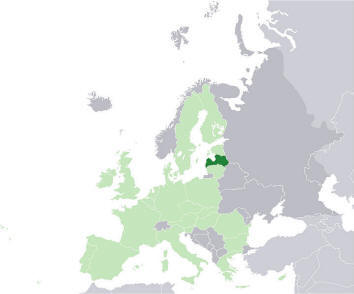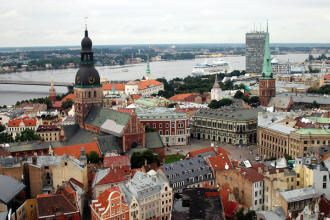Latvia: where
is it?
Latvia borders Estonia, Russia, Belarus, and Lithuania. It
is situated on a trading crossroads and has long since
served as a bridge between Western Europe and Russia. The
famous 'route of the Vikings to the Greeks' mentioned in
ancient chronicles stretched from Scandinavia through
Latvian territory along the Daugava River to the ancient
Russian and Byzantine Empire.

Latvia: a keystone of the 'New Europe'
Latvia is a keystone of Northern Europe's Baltic Seas region.
On the world map Latvia can be found in North-Eastern
Europe, on the east coast of the Baltic Sea. A country with
a language, culture and attitude all its own, yet with a
national identity shaped by the surrounding dynamic Northern
European region and woven through with diverse historical
influences. A country that survived two world wars and 50
years behind the Iron Curtain, is today completing its
second decade of renewed independence. In 2004 it became a
NATO and EU country.
Latvians?
The population of Latvia today is around 2.3 million. The
ethnic composition is around 58% Latvian and 29% Russian.
The diverse ethnic mix of the population of Latvia is
largely the result of massive post-war immigration, which
resulted in a decline in the share of ethnic Latvians from
77% in 1935 to around 58% today. There are more than 1.5
million ethnic Latvians in the world, and approximately 90%
of them live in Latvia. Other Latvians can be found in the
USA, Russia, Australia, Canada, the UK and Germany, as well
as Brazil, Lithuania, Sweden, Estonia, and Ireland. In fact,
there is hardly a country in the world where Latvians have
not made their presence felt. Even if you have not yet
visited Latvia, you stand a good chance of meeting a Latvian
somewhere else. Almost 30,000 people of Latvian descent live
in the U.S.
The Latvian
language
As one of 250 major languages in the world (spoken by more
than 1 million people), the Latvian language is also one of
the oldest. Latvian belongs to the Indo-European language
family, and together with Lithuanian, forms the Baltic
language group, related to, but separate from the Slavic and
Germanic language groups. The total number of Latvian
speakers in the world exceeds 2 million, and for 1.4 million
of them it is their native language.
Latvia's flag:
one of the oldest in existence
The Latvian flag is one of the oldest in the world. Written
records of the red-white-red Latvian flag have existed since
the second half of the 13th century. The distinctive dark
red color of the Latvian flag is sometimes referred to, by
the rest of the world, as 'Latvian red'.

Latvia: from
2000 BC to 2007 AD
The forefathers of the Latvian people first arrived in the
Baltic region in 2000 BC. In the 9th century AD the ancient
Balts began to establish specific tribal realms. The
territory of modern Latvia was inhabited by four major
Baltic tribal cultures - the Couronians, Latgallians,
Selonians and Semigallians, and a Finno-Ugric tribe, the
Livs. In the 13th century Latvia was invaded by armed
Germanic crusaders, who founded Riga and established control
over the indigenous people and territory. Over the ensuing
centuries, traders and invaders from Germany, Poland, Sweden
and Russia established a presence in Latvia, alongside the
local Latvian and Liv inhabitants.
In the late 19th century Latvia was politically ruled by
Russia and economically controlled by Baltic Germans, yet
the majority of Latvia's inhabitants were ethnic Latvians
and descendants of the original Baltic and Liv tribes. In
November 1918, the Latvian people finally established the
Latvian state.
During WW II Latvia suffered three invasions and occupations.
As many as 120,000 Latvians were deported to Soviet
concentration camps in Siberia, 140,000 fled to the West,
and thousands more perished or disappeared in the conflict.
During the Soviet occupation between 1940 and 1991, hundreds
of thousands of Soviets of various nationalities were
brought into Latvia, reducing the indigenous ethnic Latvian
population to nearly 50%.
In 1990, the people of Latvia elected a majority of
pro-independence deputies to what was then the ruling Soviet
parliamentary body, the Supreme Council of Latvia. The new
Supreme Council voted to begin the political process of
removing Soviet rule and restoring full independence to
Latvia. On 21 August 1991, following the collapse of the
Soviet Union, the Latvian Supreme Council adopted a
resolution for the full restoration of Latvian independence.
The Supreme Council was abolished in late 1992, paving way
for the first post-independence Latvian parliament, elected
on 5-6 June 1993.
The new 5th Saeima, continuing the link with the pre-war
parliaments of Latvia, elected Guntis Ulmanis the new
President of the Republic of Latvia in 1993. Re-elected in
1996, President Ulmanis was followed by Dr. Vaira
Vike-Freiberga. Dr. Vike-Freiberga was elected as President
in 1999 and re-elected for a second term in 2003. Dr. Valdia
Zalters assumed office as President on July 8, 2007.
In Latvia's parliamentary democracy, the President appoints
a Prime Minister (who must be approved by the Saeima) and
signs laws into power. Ivars Godmanis is the current Prime
Minister of Latvia.
Latvia: a
foreign policy success story
Latvia's foreign policy, like its economic policy, has been
one of the success stories of the post Cold War era. Latvia
gained EU and NATO membership in 2004, much earlier than
expected. Special ties have always existed with the United
States, which never recognized the legitimacy of Soviet rule
in Latvia following WW II. Latvia's first diplomatic mission
in the US was established in 1922 and continued to function
in Washington DC throughout the 50 years of Soviet
occupation. Full diplomatic ties were renewed in 1991 when
President George H.W. Bush was President. Subsequently,
Presidents Bill Clinton and George W. Bush have sought an
active partnership with Latvia, with President Clinton
visiting Riga in 1994 with Mrs Hillary Rodham Clinton., and
President George W. Bush in 2005 and in 2006.
Latvia in the
international arena
Latvia's commitment to global cooperation is reflected in
its membership of the WTO, World Bank, IMF,WHO and other
international bodies. Latvia has actively participated in
NATO and EU-led international operations, including
Macedonia, Bosnia-Herzogovina, Kosvo, and Afghanistan.
Latvian soldiers are currently deployed as an infantry
company, explosive ordinance disposal unit, and staff
officers in Iraq. Latvia is steadily expanding its ties with
all regions of the global community. It has 35 diplomatic
missions around the world, with embassies and trade offices
in most countries.
Latvia:
fastest growing economy in Europe" Latvia has one of the most dynamic
and fastest growing economies in all of Europe. Over the
period 1995-2007 Latvia's economy has grown by an average of
7.6%. This phenomenal success is due to effective price and
trade liberalization, small and large-scale privatization
and financial sector reform since the early 1990's. In 2005,
2006 and 2007 Latvia was the fastest growing economy in
Europe. In 2008, the IMF is forecasting some consolidation
in the pace of growth, to around 3.6%.
Latvia: a
business hub in the 'New Europe'
With its prime location as a transit hub for east-west trade,
Latvia has become one of the most favorable destinations for
foreign investment in the 'New Europe'. Sectors attracting
investors include manufacturing, forestry and woodworking,
metal processing and engineering, textiles, chemicals,
pharmaceuticals, logistics and transit, construction and
real estate, and information technology.
Latvia and
Europe: key trading partners
The European Union accounts for 80% of Latvia's total trade.
Latvia's major trading partners include Germany, Sweden, the
UK, Russia and neighboring Baltic countries such as Estonia
and Lithuania.
Latvia: some
of the lowest taxes in Europe
Latvia has one of the lowest tax burdens in Europe:
corporate tax rate at a flat 15% and individual taxes at
25%.
Latvia's
currency: the lat
From its inception, the Latvian currency, the lat, has been
one of the most stable currencies in Europe. In 2005, after
joining the EU and developing a strategy to join the
European Monetary Union, the lat was pegged to the euro (1
LVL = 0.702804 EUR). The exchange rate vs. the dollar is
1USD = 0.440 LVL (as of 4/11/2008).
Latvia:
investment grade status
Latvia has an investment grade credit rating in
international markets.
RIX: Latvia's
fast growing international airport
RIX - Riga's International Airport - is rapidly emerging as
a new strategic hub for international tourist, business and
related travel in the Baltic Sea region. Latvia can be
reached from the US either direct from JFK or via convenient
connections via most European capital cities, including
Helsinki, Copenhangen, Stockholm, Amsterdam, Frankfurt,
Paris, Zurich, Vienna, as well as via London.
Latvia's
capital, Riga: The 'Paris of the North'
One hundred years ago Riga was known as the 'Paris of the
North'. 800 years young, Riga is now called 'The Second City
that Never Sleeps', and the 'Hottest City in the North'. As
it moves into the 21st century, Riga is blossoming as a
creative centre for the arts once again. Local and visiting
art exhibits and the opera, theatre and ballet compete with
nightclubs and discos that rock with jazz, blues and the
latest electronic fusions of hip hop and dance music.
Riga: Art
Nouveau capital of the world
Riga is architecturally considered to be the Jugendstil
capital of the world. Latvian architects are responsible for
designing over 60% of the distinctive Art Nouveau style
buildings made famous in the early 1900's.

Riga: a UNESCO
designated cultural and natural site
Nearly one-third of Latvia's population (747,000) lives in
the capital Riga. Riga, the oldest existing medieval city,
was founded in 1201. Riga has been included in UNESCO's list
of the world's most important cultural and natural sites.
Latvia's
National Day
November 18 is Latvia's National Holiday. Latvia's
independence was proclaimed in Riga on November 18, 1918. As
part of the 90th year anniversary, a Celebratory Diary can
be seen at
www.lv90.lv. This website details more than 600 events
that will take place in Latvia during 2008 to commemorate
Latvia's founding as an independent nation.
Latvia: one of
the greenest countries in Europe
Latvia's landscape is marked by lowland plains, rolling
hills, thousands of rivers and lakes. Forests cover 44
percent of the territory, and most of the countryside is
less than 100 meters above sea level.
For more information on Latvia, see
The Latvian Institute website:
www.li.lv
|